This post is part of a larger deep dive
Curious about the role of Edgar Allan Poe’s "The Narrative of Arthur Gordon Pym of Nantucket" in Not to Be Reproduced? Check out Not to Be Reproduced Explained
Or read the full Not to Be Reproduced article!
This post is part of a larger deep dive
Curious about the role of Edgar Allan Poe’s "The Narrative of Arthur Gordon Pym of Nantucket" in Not to Be Reproduced? Check out Not to Be Reproduced Explained
Or read the full Not to Be Reproduced article!
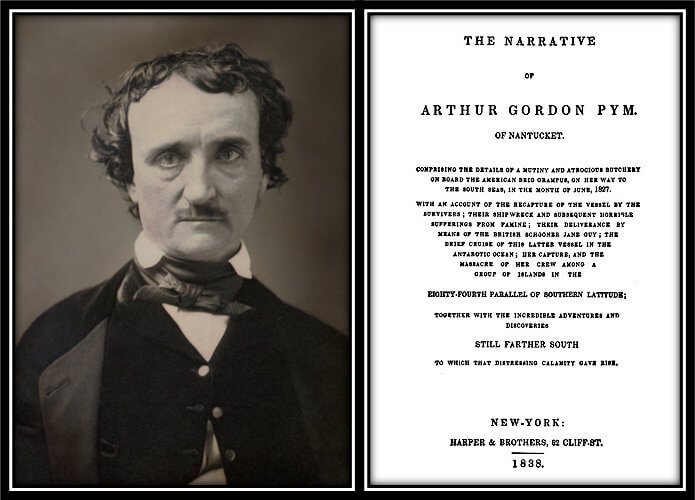
If you haven’t done so yet, check out our article about Poe’s novel The Narrative of Arthur Gordon Pym of Nantucket, in which we analyse and provide a few interpretations of the novel.
The book starts off with a preface which was allegedly written by the protagonist of the novel, Arthur Gordon Pym himself.
Pym begins by saying that he was initially reluctant to publish his adventures, since his experiences at sea were so bizarre and outrageous that he feared readers would dismiss his account as mere fable.
Furthermore, he admits that he did not keep a diary during most of the journey, so the retelling of the events from memory might suffer from a slight exaggeration on his part. He suspects that only family and close friends would probably believe him.
Pym is also self-critical about his writing abilities, which further lessened his enthusiasm to turn his narrative public.
An editor of the magazine Southern Literary Messenger, a so-called Mr. Poe, persuades Pym to publish the work under the guise of fiction.
So, straight from the beginning, we are confronted with the possibility that Pym’s account is all but balderdash. The reader is warned about the divergence of thoughts (Pym believes it is true but admits he might be making up some of the details; Pym writes that only his friends might believe him but not the general public).
You see, Poe could have omitted the aspects that make us question Pym’s account. For example, he could have presented the story as is, without making any reference to whether people believed Pym or not. But Poe deliberately introduces ambiguity in the preface. He makes us aware of the dubious narrative that Pym has purpotedly written.
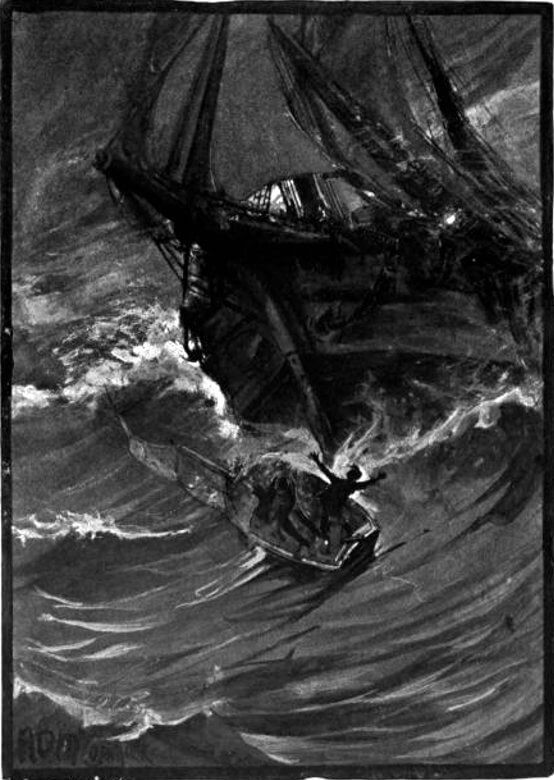
After the preface, the actual narrative starts. The first chapter tells Pym’s adventures at sea with his friend Augustus aboard Pym’s small boat “Ariel”.
Pym suffers his first nautical disaster, but is rescued by a frigate by the name of Penguin.
The preface mentions that the Ariel story was actually written by Mr. Poe, even though it is told from Pym’s first perspective narration. Once again, this superfluous information, which could just as well have been ommitted without sacrificing the narrative, has the effect of confusing the reader even more.
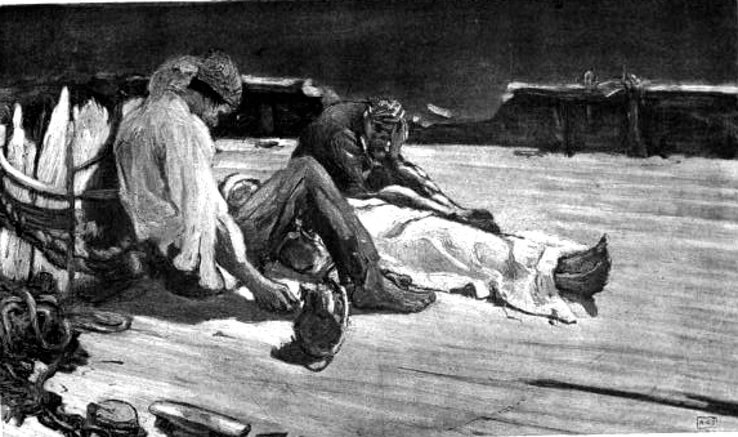
The next chapters deal with Pym’s (mis)adventures on board of the whaling-ship “Grampus”.
After sneaking Pym onto the ship, Augustus hides him in a hold and instructs him to remain there until the Grampus is sufficiently far away from the coast, that the captain of the ship will have no other option but to continue his journey with Pym aboard.
However, when Augustus fails to come down after a few days with provisions and water, Pym becomes delirious and almost dies of thirst and hunger.
He is saved in the nick of time by Augustus, who explains that mutiny broke out, which was the reason for not coming down earlier.
Pym forges an alliance with Augustus and another crew member called Peters, and the three men successfully quell the mutiny.
However, a violent storm severely damages the ship, eventually capsizing it. The demoralised crew face starvation, and resort to cannibalism of a fellow crew member.
Pym faces many tribulations: gruesome sightings of putrefied bodies on a passing ship; the constant surveillance of hungry sharks; and the prospect of dying from hunger and/or dehydration. Augustus dies, but Pym and Peters are eventually rescued by Jane Guy, a ship en route to the South Pole on an exploration mission.
It is worth noting that there are at least two very noticeable mistakes in Pym’s narration.
First, Pym owns a dog, Tiger, which plays a prominent role in saving Pym’s life more than once aboard the Grampus.
However, Tiger mysteriously vanishes after they put a stop to the mutiny, and Pym provides no explanation of its whereabouts.
Second, Pym writes that Augustus almost gave up on Pym when he couldn’t find him on the hold, thinking he might already be dead. Pym also writes that many years ellapsed before Augustus plucked the courage to tell Pym. Yet, Augustus dies a few weeks later while still on Grampus.
Being the experienced writer Poe was, it is indeed very strange that he would make two obvious blunders of this kind.
Perhaps Poe deliberately distorted the storyline in order to increase the ambiguity with regards to the truthfulness of Pym’s telling of the events.
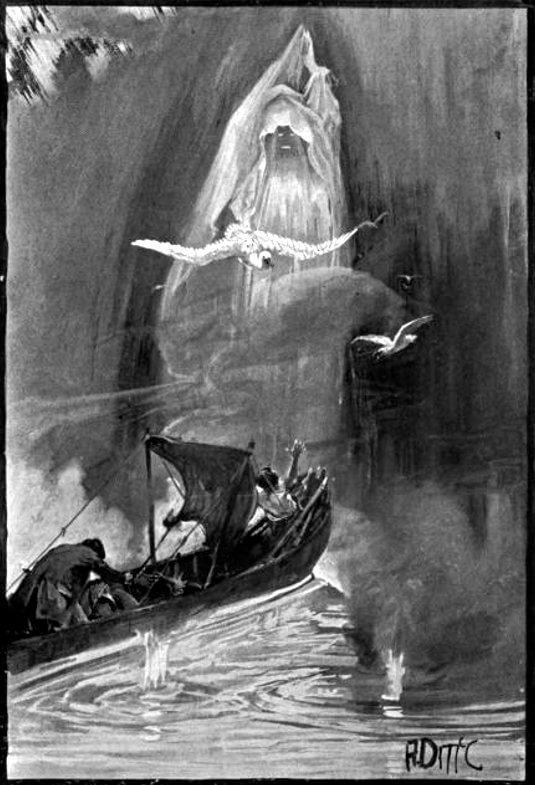
The last chapters of the book introduce us to the southern island of Tsalal and its inhabitants, a tribe of black natives that fear anything white.
Even though being initially cordial towards the crew, they eventually reveal their nefarious purpose of killing every single member of the crew.
Pym and Peters barely survive the ambush laid out by the islanders, and escape the island on a canoe with a captured native.
As they sail southwards towards the south pole, they begin to witness strange phenomena: water becomes warmer, thicker and milky white; they see strange all-white animals flying above their heads; ash puring down; a curtain of vapour rising on the southern horizon.
The novel ends abruptly, just as Pym and Peters approach a chasm and a giant human white figure emerges.
So, Pym’s account ends in such an anti-climatic and puzzling fashion that the reader feels completely baffled as to what the heck is going on.
The bizarre sightings (e.g., gigantic white animals, curtain of vapour covering the entirety of the southern horizon, huge human figure) are just so strange and displaced when considering the rest of the novel, that we feel, once again, that Pym may be making this stuff up.
In fact, there is a point when the three men (Pym, Peters and the captured native) begin to lose control of their senses and become apathetic.
There are also mentionings of dreaminess and numbness of mind as they approach the chasm, which could suggest that Pym wasn’t in full possession of his faculties.
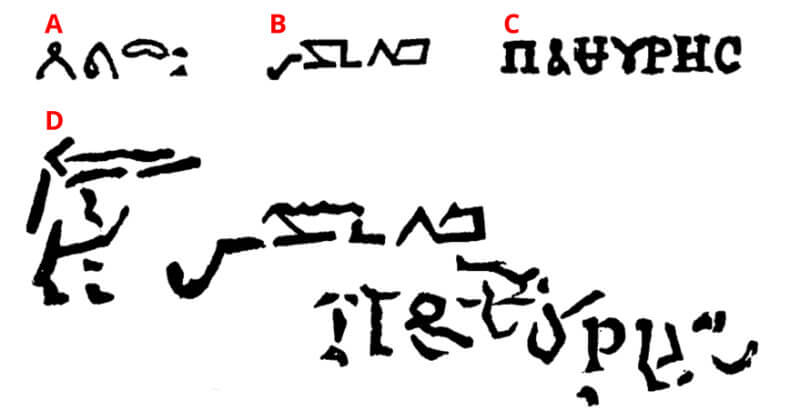
There is a post-scriptural note ostensibly written by the editor of the book. It is explained that Pym survived his ordeal and returned safely to the US, dying in an accident later in his life.
The editor suspects that there might exist two or three chapters which would provide a closure to Pym’s tale, but they were, unfortunately, lost with him.
The editor continues saying that Peters is alive and lives in Illinois, but he is unreachable.
The book ends with an attempt to explain strange markings on the Tsalal rocks that Pym drew on a piece of paper, which turn out to be of African and Arabic origins (see figure above).
Once again, we are presented with more dubious information.
First, Peters is alive but unreachable?!? So, the only person that could settle, once and for all, the veracity of Pym’s account is unexplicably unavailable!!
Again, Poe could have just written that both Pym and Peters died and that would be the end of it. But, no, Peters is alive but won’t talk. Can there anything be more suspicious than that?
Also, the post-scriptural note spends a great deal of time discussing a few markings that Pym had encountered on the Tsalalian rocks and which were only secondary to the story.
Pym was convinced that the markings were the work of nature. In contrast, Peters, who happened to be around Pym when he stumbled across the rock markings, correctly believed the markings to be alphabetical characters.
Well, the editor actually sides with Peters and corrects Pym’s interpretation in the post-scriptural note.
So, once again, we have the editor of the book pointing out the inadequacy of Pym’s interpretation, making his character even less reliable.
Masterpiece
cool
super cool thanks saved my work
Hi Pipinha,
I’m glad the article was useful to you!